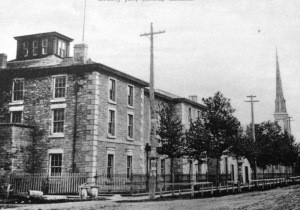
June 19, 1873. Executed this day for the murder of her husband was Elizabeth Workman of Mooretown, Ontario.
A coroner’s inquest into the death of James Workman found that he died from “excessive violence,” administered by his wife or by Samuel Butler, the owner of a barbershop where Elizabeth did part-time work as a cleaner, or by both of them. There were bruises on James’s legs, indicating that they had been tied together with rope. The coroner found it necessary to mention that Butler was a Black man, the implication being that this was relevant to the case. Both Elizabeth Workman and Samuel Butler were taken into custody and charged with murder.
Witnesses at Elizabeth’s trial testified that a couple of days before his death in October 1872 James arrived drunk and belligerent at Butler’s shop, where Elizabeth was hard at work cleaning the floors. He insisted that she should come home with him. The barber intervened with some force, pushing James out into the street. Possibly not wanting a scene, Elizabeth left with her husband. However, she was so furious with him that, according to her young son, Hugh, she beat him severely with a mop handle, so severely that James was obliged to take to his bed. James was down but certainly not out. He continued to lash out verbally at his wife, and she responded by hitting him. She told a neighbour that she merely wanted to teach James a lesson to prevent him from hurting her in the future. Butler visited the house a couple of times during that period, but he was not there when James died.
The trial judge, Adam Wilson, ruled that although there seemed to have been an “improper intimacy” between Samuel and Elizabeth, the man should be acquitted as there was no evidence against him. However, when it came to Elizabeth, the judge was caustic. He characterized her as an adulterous and sadistic woman who tied her husband up and battered him for hours with a mop handle, finally killing him. Despite the jury’s plea for clemency, the judge followed up his negative statements at the trial with a letter to the minister of justice saying that he had nothing favourable to say about Elizabeth, and that she alone committed the acts she was charged with.
However, as Scott Gaffield points out in his thoughtful article “Justice Not Done: The Hanging of Elizabeth Workman,” the facts of the case were far more nuanced, and a vigorous defence might have brought these subtleties to light in court. The marriage of Elizabeth and her much older husband was very troubled. James laid claim to his wife’s earnings and was physically as well as verbally abusive to her, a trait very much exacerbated by his excessive drinking. Elizabeth, on the contrary, was described by all as a devoted wife and mother who was obliged to work outside the home to help her family survive.
Most of the evidence against Elizabeth was circumstantial and could have lent itself to alternative interpretations in the hands of a skilled lawyer. Did Elizabeth tie her husband down to brutalize him, or was this merely an act of self defence? Did Butler visit the house to protect Elizabeth rather than to cuckold her husband? And talking of Butler, the man had a fierce temper and he had been heard threatening James. Was the judge correct in dismissing the case against him, or did he actually have a hand in James’s death? Much of the physical evidence was gone. A neighbour and James’s daughter cleaned his body before the authorities arrived, and the alleged murder weapon, the mop handle, was thrown away.
But Elizabeth Workman’s defence was very much less than vigorous. When her trial opened in March 1873, the court found that she had no lawyer, and she could not afford to hire one. A local barrister, John A. Mackenzie, was hastily recruited to act as her lawyer. Mackenzie had a few short hours to familiarize himself with the facts and come up with a defence. All he managed to do was provide a statement of Elizabeth’s innocence. He did not question or challenge witnesses during the two-day trial, nor mention his client’s good character or the fact that she was more than likely a battered wife.
There was a huge groundswell of support for Elizabeth, not just from the public (118 people from the Mooretown area alone signed a petition protesting against her sentence) but from prominent members of the community such as the mayor and the sheriff, and even the future prime minister of Canada, Alexander Mackenzie.
These efforts were all in vain: on June 19, 1873, clutching a small bunch of flowers, Elizabeth Workman was hanged. She fell directly into her grave through a trap in a purpose-built scaffold at the Sarnia Gaol in Ontario. She has gone down in history as the only woman executed in Canada despite a jury’s plea for mercy.